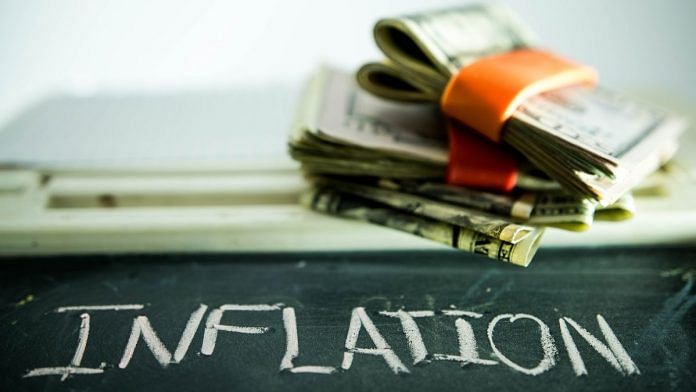
Thank you dear subscribers, we are overwhelmed with your response.
Your Turn is a unique section from ThePrint featuring points of view from its subscribers. If you are a subscriber, have a point of view, please send it to us. If not, do subscribe here: https://theprint.in/subscribe/
What is inflation? How is it measured?
Inflation is an indicator of how much more money you have to spend to satisfy your needs with respect to a reference point. For example, suppose you have only two needs, that of food and clothing. You spend 80 INR on food and 20 INR on clothing in Year 1. Next year prices have increased and now you have to spend 84 INR and 26 INR on food and clothing respectively, to consume the same quantity of these goods that you consumed last year. As a result total expenses for Year 2 have increased to 110 INR from 100 INR in Year 1 . Thus Inflation in Year 2 with respect to Year 1 is 10% because you had to spend 10% more in Year 2 than Year 1 in order to maintain your consumption level.
In real life our expenses are not limited to just food and clothing. Education, health etc are some of the other expenses we have to address. Through use of various surveys, government agencies construct a basket of goods and services. This basket indicates, on an average basis, which goods and services a consumer consumes in a year and in what proportion. Various baskets can be constructed keeping different population groups and different purposes in mind. The Consumer Price Inflation (combined) i.e CPI(C) is the most popular basket as it indicates consumption by consumers averaged across the entirety of the country.
For base year (Year 1 in the example in the 2nd para) the total cost of the basket is always taken as 100. The cost of the basket will change over the years due to change in prices of its constituent goods and services. The cost of the basket is called the index level.
The base year used for CPI is 2012. It’s composition is given below
The table can be interpreted in the following manner. An average consumer spent 45.86 INR out of every 100 INR of his expenditure on food and beverages in 2012. For calculation of inflation in coming years, it is assumed that the quantities and the relative proportions of the goods and services in the basket would remain the same for an average consumer in the coming years. Inflation at a given point is calculated as % change in the index level with respect to a reference point.
How was 7% CPI inflation rate as of Aug 2022 calculated?
In August 2022 the value of CPI(combined) index stood at 174.3 which means to buy the items mentioned in the above table in the same quantities they were bought in 2012 we would have to spend 174.3 INR in Aug 2022 instead of the 100 INR required in 2012. Therefore the inflation rate in Aug 2022 is 74.3% with respect to base year of 2012.
Then what is the 7% figure which is doing rounds in the media?
Well in regular usage inflation rate at any given point is calculated as % change in the index level with respect to the index level before 1 year instead of the index level at base year. In Aug 2021 the basket value was 162.9. Therefore the inflation rate as of Aug 2022 as been calculated in the following manner-
((Aug 2022 index level – Aug 2021 index level)/Aug 2021 index level)*100
and this is gives us the 7% number.
Interesting Insight : CPI is a weighted average rate of the basket constituents. But inflation would be different for different components in the basket. The CPI rate , therefore, makes little sense for an individual because his consumption pattern might be very different from the average consumer’s pattern as indicated by the CPI basket. A person who needs to travel a lot for his work would experience a much higher inflation rate than CPI rate because fuel prices have increased much more than prices of other items. Again a family with 3 kids pursuing higher education would be much more impacted by inflation in education than the inflation in other items. CPI rates might be helpful in making macroeconomic policy decisions but they are of lesser consequence for individuals. Therefore instead of worrying about CPI inflation rates it would serve the individuals well if they focus more on their own expenses and how to control them.
Also read: Subscriber writes poem on women empowerment
These pieces are being published as they have been received – they have not been edited/fact-checked by ThePrint.


COMMENTS